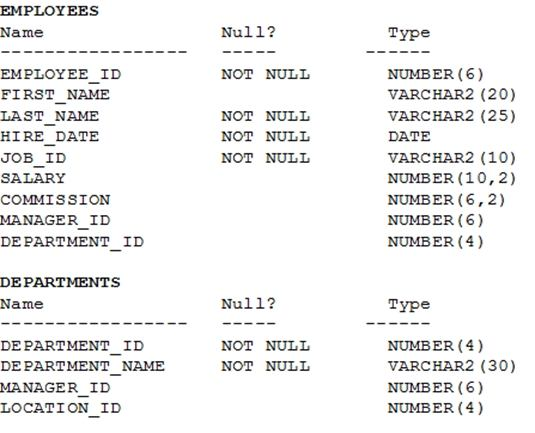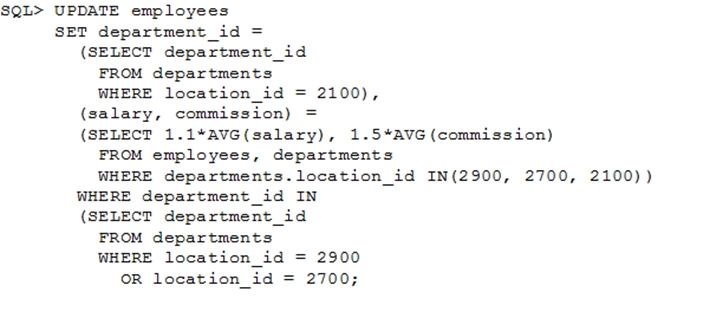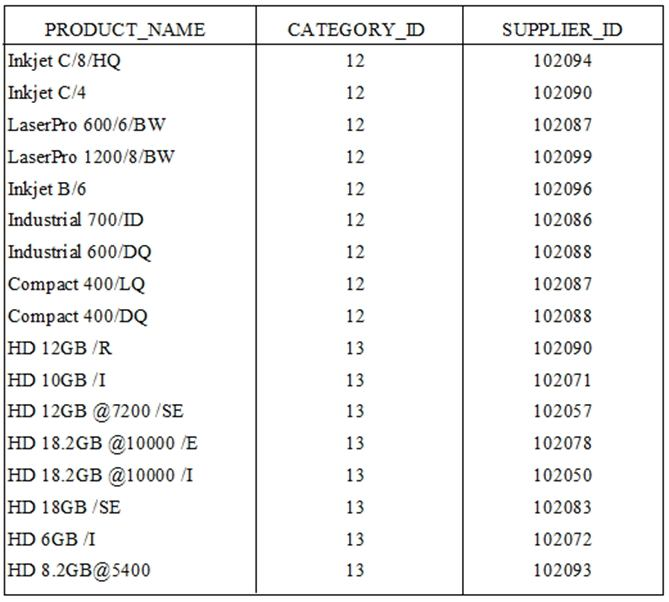File Info
| Exam | Oracle Datbase 12c SQL |
| Number | 1z0-071 |
| File Name | Oracle.1z0-071.SelfTestEngine.2020-04-15.207q.vcex |
| Size | 18 MB |
| Posted | Apr 15, 2020 |
| Download | Oracle.1z0-071.SelfTestEngine.2020-04-15.207q.vcex |
How to open VCEX & EXAM Files?
Files with VCEX & EXAM extensions can be opened by ProfExam Simulator.
Coupon: MASTEREXAM
With discount: 20%





Demo Questions
Question 1
Evaluate the following SQL statement:
SQL> select cust_id, cust_last_name "Last name"
FROM customers
WHERE country_id = 10
UNION
SELECT cust_id CUST_NO, cust_last_name
FROM customers
WHERE country_id = 30
Identify three ORDER BY clauses either one of which can complete the query.
- ORDER BY "Last name"
- ORDER BY 2, cust_id
- ORDER BY CUST_NO
- ORDER BY 2, 1
- ORDER BY "CUST_NO"
Correct answer: ABD
Explanation:
Using the ORDER BY Clause in Set Operations The ORDER BY clause can appear only once at the end of the compound query. Component queries cannot have individual ORDER BY clauses. The ORDER BY clause recognizes only the columns of the first SELECT query. By default, the first column of the first SELECT query is used to sort the output in an ascending order. Using the ORDER BY Clause in Set Operations
- The ORDER BY clause can appear only once at the end of the compound query.
- Component queries cannot have individual ORDER BY clauses.
- The ORDER BY clause recognizes only the columns of the first SELECT query.
- By default, the first column of the first SELECT query is used to sort the output in an ascending order.
Question 2
Which three statements are true regarding the WHERE and HAVING clauses in a SQL statement? (Choose three.)
- WHERE and HAVING clauses cannot be used together in a SQL statement.
- The HAVING clause conditions can have aggregate functions.
- The HAVING clause conditions can use aliases for the columns.
- The WHERE clause is used to exclude rows before the grouping of data.
- The HAVING clause is used to exclude one or more aggregated results after grouping data.
Correct answer: BDE
Question 3
Which statement is true regarding external tables?
- The CREATE TABLE AS SELECT statement can be used to upload data into a normal table in the database from an external table.
- The data and metadata for an external table are stored outside the database.
- The default REJECT LIMIT for external tables is UNLIMITED.
- ORACLE_LOADER and ORACLE_DATAPUMP have exactly the same functionality when used with an external table.
Correct answer: A
Explanation:
References:https://docs.oracle.com/cd/B28359_01/server.111/b28310/tables013.htm References:
https://docs.oracle.com/cd/B28359_01/server.111/b28310/tables013.htm
Question 4
Which two statements are true regarding constraints? (Choose two)
- A constraint is enforced only for an INSERT operation on a table.
- A foreign key cannot contain NULL values.
- A column with the UNIQUE constraint can store NULLS.
- You can have more than one column in a table as part of a primary key.
Correct answer: CD
Question 5

View the Exhibit and examine the structure of ORDERS and ORDER_ITEMS tables.
ORDER_ID is the primary key in the ORDERS table. It is also the foreign key in the ORDER_ITEMS table wherein it is created with the ON DELETE CASCADE option.
Which DELETE statement would execute successfully?

- DELETE orders o, order_items iWHERE o.order_id = i.order_id;
- DELETEFROM ordersWHERE (SELECT order_idFROM order_items);
- DELETE ordersWHERE order_total < 1000;
- DELETE order_idFROM ordersWHERE order_total < 1000;
Correct answer: C
Question 6


View the exhibit and examine the structures of the EMPLOYEES and DEPARTMENTS tables.

You want to update EMPLOYEES table as follows:
- Update only those employees who work in Boston or Seattle (locations 2900 and 2700).
- Set department_id for these employees to the department_id corresponding to London (location_id 2100).
- Set the employees' salary in location_id 2100 to 1.1 times the average salary of their department.
- Set the employees' commission in location_id 2100 to 1.5 times the average commission of their department.
You issue the following command:

What is outcome?
- It generates an error because multiple columns (SALARY, COMMISSION) cannot be specified together in an UPDATE statement.
- It generates an error because a subquery cannot have a join condition in a UPDATE statement.
- It executes successfully and gives the desired update
- It executes successfully but does not give the desired update
Correct answer: D
Question 7

Evaluate the following two queries:

Which statement is true regarding the above two queries?
- Performance would improve in query 2 only if there are null values in the CUST_CREDIT_LIMIT column.
- There would be no change in performance.
- Performance would degrade in query 2.
- Performance would improve in query 2.
Correct answer: B
Question 8
Examine the business rule:
Each student can work on multiple projects and each project can have multiple students.
You must design an Entity Relationship (ER) model for optimal data storage and allow for generating reports in this format:
STUDENT_ID FIRST_NAME LAST_NAME PROJECT_ID PROJECT_NAME PROJECT_TASK
Which two statements are true? (Choose two.)
- The ER must have a 1-to-many relationship between the STUDENTS and PROJECTS entities.
- The ER must have a many-to-many relationship between the STUDENTS and PROJECTS entities that must be resolved into 1-to-many relationships.
- STUDENT_ID must be the primary key in the STUDENTS entity and foreign key in the PROJECTS entity.
- PROJECT_ID must be the primary key in the PROJECTS entity and foreign key in the STUDENTS entity.
- An associative table must be created with a composite key of STUDENT_ID and PROJECT_ID, which is the foreign key linked to the STUDENTS and PROJECTS entities.
Correct answer: BE
Explanation:
References:http://www.oracle.com/technetwork/issue-archive/2011/11-nov/o61sql-512018.html References:
http://www.oracle.com/technetwork/issue-archive/2011/11-nov/o61sql-512018.html
Question 9

View the Exhibit and examine the details of PRODUCT_INFORMATION table.

You have the requirement to display PRODUCT_NAME from the table where the CATEGORY_ID column has values 12 or 13, and the SUPPLIER_ID column has the value 102088. You executed the following SQL statement:
SELECT product_name
FROM product_information
WHERE (category_id = 12 AND category_id = 13) AND supplier_id = 102088;
Which statement is true regarding the execution of the query?
- It would not execute because the same column has been used in both sides of the AND logical operator to form the condition.
- It would not execute because the entire WHERE clause condition is not enclosed within the parentheses.
- It would execute and the output would display the desired result.
- It would execute but the output would return no rows.
Correct answer: D
Question 10
Which two statements are true regarding the EXISTS operator used in the correlated subqueries? (Choose two.)
- The outer query stops evaluating the result set of the inner query when the first value is found.
- It is used to test whether the values retrieved by the inner query exist in the result of the outer query.
- It is used to test whether the values retrieved by the outer query exist in the result set of the inner query.
- The outer query continues evaluating the result set of the inner query until all the values in the result set are processed.
Correct answer: AC
Explanation:
References:http://www.techonthenet.com/oracle/exists.php References:
http://www.techonthenet.com/oracle/exists.php

